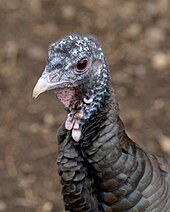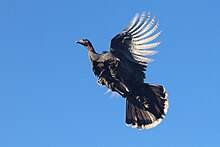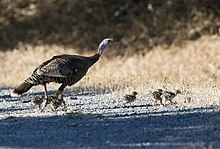The wild turkey (Meleagris gallopavo) is an upland ground bird native to North America and is the heaviest member of the diverse Galliformes. It is the same species as the domestic turkey, which was originally derived from a southern Mexican subspecies of wild turkey (not the related ocellated turkey).
Although native to North America, the turkey probably got its name from
the domesticated variety being imported to Britain in ships coming from
the Levant via Spain. The British at the time therefore associated the wild turkey with the country Turkey and the name prevails.
Description
Adult wild turkeys have long reddish-yellow to grayish-green legs. The
body feathers are generally blackish and dark, sometimes grey brown
overall with a coppery sheen that becomes more complex in adult males.
Adult males, called toms or gobblers, have a large, featherless, reddish
head, red throat, and red wattles on
the throat and neck. The head has fleshy growths called caruncles.
Juvenile males are called jakes; the difference between an adult male
and a juvenile is that the jake has a very short beard and his tail fan
has longer feathers in the middle. The adult male's tail fan feathers
will be all the same length.[5] When
males are excited, a fleshy flap on the bill expands, and this, the
wattles and the bare skin of the head and neck all become engorged with
blood, almost concealing the eyes and bill. The long fleshy object over a
male's beak is called a snood. Each foot has three toes in front, with a shorter, rear-facing toe in back; males have a spur behind each of their lower legs.[6]
Male turkeys have a long, dark, fan-shaped tail and glossy bronze wings. As with many other species of the Galliformes, turkeys exhibit strong sexual dimorphism. The male is substantially larger than the female, and his feathers have areas of red, purple, green, copper, bronze, and gold iridescence. The preen gland (uropygial gland)
is also larger in male turkeys compared to female ones. In contrast to
the majority of other birds, they are colonized by bacteria of unknown
function (Corynebacterium uropygiale).[7] Females,
called hens, have feathers that are duller overall, in shades of brown
and gray. Parasites can dull coloration of both sexes; in males,
coloration may serve as a signal of health.[8] The primary wing feathers have white bars. Turkeys have 5000 to 6000 feathers.[9] Tail
feathers are of the same length in adults, different lengths in
juveniles. Males typically have a "beard", a tuft of coarse hair
(modified feathers) growing from the center of the breast. Beards
average 230 mm (9.1 in) in length. In some populations, 10 to 20% of
females have a beard, usually shorter and thinner than that of the male.
The adult male (or "tom") normally weighs from 5 to 11 kg (11 to 24 lb)
and measures 100–125 cm (39–49 in) in length. The adult female (or
"hen") is typically much smaller at 2.5–5.4 kg (5.5–11.9 lb) and is 76
to 95 cm (30 to 37 in) long.[10][11] Per
two large studies, the average weight of adult males is 7.6 kg (17 lb)
and the average weight of adult females is 4.26 kg (9.4 lb).[12][13] The
wings are relatively small, as is typical of the galliform order, and
the wingspan ranges from 1.25 to 1.44 m (4 ft 1 in to 4 ft 9 in). The wing chord is only 20 to 21.4 cm (7.9 to 8.4 in). The bill is also relatively small, as adults measure 2 to 3.2 cm (0.79 to 1.26 in) in culmen length.[14] The tarsus of
the wild turkey is quite long and sturdy, measuring from 9.7 to 19.1 cm
(3.8 to 7.5 in). The tail is also relatively long, ranging from 24.5 to
50.5 cm (9.6 to 19.9 in).[15] The record-sized adult male wild turkey, according to the National Wild Turkey Federation, weighed 16.85 kg (37.1 lb), with records of tom turkeys weighing over 13.8 kg (30 lb) uncommon but not rare.[16]While it is usually rather lighter than the waterfowl, after the trumpeter swan (Cygnus buccinator),
the turkey has the second heaviest maximum weight of any North American
bird. Going on average mass, several other birds on the continent,
including the American white pelican (Pelecanus erythrorhynchos), the tundra swan (Cygnus columbianus columbianus) and the very rare California condor (Gymnogyps californianus) and whooping crane (Grus americana)
surpass the mean weight of turkeys. On one hand, none of these other
species are as sexually dimorphic in size as the wild turkey, but on the
other, they are also far less numerous and are not legally hunted
unlike the turkey, thousands of which are weighed every year during
hunting season.[17][18]
Habitat
Wild turkeys prefer hardwood and mixed conifer-hardwood forests with scattered openings such as pastures, fields, orchards and seasonal marshes.
They seemingly can adapt to virtually any dense native plant community
as long as coverage and openings are widely available. Open, mature
forest with a variety of interspersion of tree species appear to be
preferred. In the Northeast of North America, turkeys are most profuse
in hardwood timber of oak-hickory (Quercus-Carya) and forests of red oak (Quercus rubra), beech (Fagus grandifolia), cherry (Prunus serotina) and white ash (Fraxinus americana).
Best ranges for turkeys in the Coastal Plain and Piedmont sections have
an interspersion of clearings, farms, and plantations with preferred
habitat along principal rivers and in cypress (Taxodium distichum) and tupelo (Nyssa sylvatica)
swamps. Appalachian and Cumberland plateaus, birds occupy mixed forest
of oaks and pines on southern and western slopes, also hickory with
diverse understories. Bald cypress and sweet gum (Liquidambar styraciflua) swamps of s. Florida; also hardwood of Cliftonia (a heath) and oak in north-central Florida. Lykes Fisheating Creek area of s. Florida has up to 51% cypress, 12% hardwood hammocks, 17% glades of short grasses with isolated live oak (Quercus virginiana); nesting in neighboring prairies. Original habitat here was mainly longleaf pine (Pinus palustris) with turkey oak (Quercus laevis) and slash pine (Pinus caribaea) "flatwoods," now mainly replaced by slash pine plantations.
Behavior
Flight
Despite their weight, wild turkeys, unlike their domesticated counterparts, are agile fliers. In ideal habitat of open woodland or wooded grasslands,[19] they
may fly beneath the canopy top and find perches. They usually fly close
to the ground for no more than 400 m (a quarter mile).
Vocalizations
Turkeys have many vocalizations: "gobbles", "clucks", "putts", "purrs",
"yelps", "cutts", "whines", "cackles", and "kee-kees". In early spring,
males older than 1-year-old (sometimes called gobblers or toms) and,
occasionally to a lesser extent, males younger than 1-year-old
(sometimes called jakes) gobble to announce their presence to females
and competing males. The gobble can carry for up to a mile. Males also
emit a low-pitched "drumming" sound; produced by the movement of air in
the air sack in the chest, similar to the booming of a prairie chicken.
In addition they produce a sound known as the "spit" which is a sharp
expulsion of air from this air sack. Hens "yelp" to let gobblers know
their location. Gobblers often yelp in the manner of females, and hens
can gobble, though they rarely do so. Immature males, called jakes,
often yelp.
Foraging
Wild turkeys are omnivorous, foraging on the ground or climbing shrubs and small trees to feed. They prefer eating acorns, nuts and other hard mast of various trees, including hazel, chestnut, hickory, and pinyon pine as well as various seeds, berries such as juniper and bearberry, roots and insects. Turkeys also occasionally consume amphibians and small reptiles such as lizards and snakes. Poults have been observed eating insects, berries, and seeds. Wild turkeys often feed in cow pastures,
sometimes visit back yard bird feeders, and favor croplands after
harvest to scavenge seeds on the ground. Turkeys are also known to eat a
wide variety of grasses.
Turkey populations can reach large numbers in small areas because of
their ability to forage for different types of food. Early morning and
late afternoon are the desired times for eating.
Social structure and mating
Males are polygamous,
mating with as many hens as they can. Male wild turkeys display for
females by puffing out their feathers, spreading out their tails and
dragging their wings. This behavior is most commonly referred to as
strutting. Their heads and necks are colored brilliantly with red, blue
and white. The color can change with the turkey's mood, with a solid
white head and neck being the most excited. They use gobbling,
drumming/booming and spitting as signs of social dominance, and to
attract females. Courtship begins during the months of March and April,
which is when turkeys are still flocked together in winter areas.
Males may be seen courting in groups, often with the dominant male
gobbling, spreading their tail feathers (strutting), drumming/booming
and spitting. In a study, the average dominant male that courted as part
of a pair of males fathered six more eggs than males that courted
alone. Genetic analysis of pairs of males courting together shows that
they are close relatives, with half of their genetic material being
identical. The theory behind the team-courtship is that the less
dominant male would have a greater chance of passing along shared
genetic material than if it were courting alone.[20]
When mating is finished, females search for nest sites. Nests are
shallow dirt depressions engulfed with woody vegetation. Hens lay a
clutch of 10–14 eggs, usually one per day. The eggs are incubated for at
least 28 days. The poults are precocial and nidifugous, leaving the nest in about 12–24 hours.
Predators
Predators of eggs and nestlings include raccoons (Procyon lotor), Virginia opossums (Didelphis virginiana), striped skunks (Mephitis mephitis), gray foxes (Urocyon cinereoargenteus), groundhogs (Marmota monax), other rodents and spotted skunks (Spilogale ssp.).[21][22][23][24] Predators of poults in addition to nestlings and eggs also include several snakes, namely rat snakes (Elaphe ssp.), gopher snakes (Pituophis catenifer) and pinesnakes (Pituophis ssp.), and predators mainly on poults include raptors such as bald eagles (Haliaeetus leucocephalus), barred owl (Strix varia), red-shouldered (Buteo lineatus), red-tailed (Buteo jamaicensis), white-tailed (Geranoaetus albicaudatus) and harris's hawks (Parabuteo unicinctus) and even the smallish Cooper's hawk (Accipiter cooperii) and broad-winged hawk (Buteo platypterus) (both likely of very small poults).[25][26][27][28][29][30] Mortality
of poults is greatest in the first 14 days of life, especially of those
roosting on the ground, decreasing most notably after half a year, when
they attain near adult sizes.






No comments:
Post a Comment